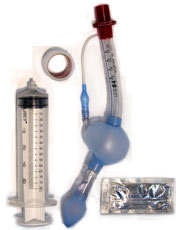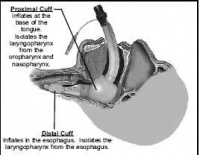King Tube
From Protocopedia
Procedure Guidelines
9.18 KING TUBE
KING LTS-D LARYNGEAL TUBE AIRWAY:
The King LTS-D is a double-lumen supralaryngeal device with oropharyngeal and esophageal low-pressure cuffs, a ventilation outlet between the two cuffs, and a blind distal tip. The King Tube is designed for positive pressure ventilation over 30 cm H2O and spontaneously breathing patients, yet offers the unique ability to easily pass a gastric tube through a second channel of the airway and into the esophagus and stomach. The anatomically shaped distal tip and cuff assist in the airway’s passage behind the larynx and into the normally collapsed esophagus.
The second lumen of the KING LTS-D, which is open at the distal tip of the tube, provides three key additional benefits:
- Passage of gastric tube up to 18 French
- Channel for regurgitation, which significantly reduces potential for regurgitation to get past the cuff and therefore aids in reducing the chance for aspiration
- Provides “vent” for gastric pressure and stomach decompression.
INDICATIONS:
- Primary airway management in cardiac arrest
- Failed intubation
- Difficult airway cases
- Upper gastrointestinal or airway hemorrhage that threatens airway patency.
CONTRAINDICATIONS:
- Responsive patient with intact airway –protective reflexes
- Patients with known esophageal disease
- Caustic ingestions
- Upper-airway obstructions due to foreign bodies or pathology
- Children/adults less than 4-feet tall.

EQUIPMENT:
- BVM
- Lubricant
- 60-90 cc syringe
- ET Tube holder
- EtCO2 sensor
- Gastric tube up to 18F

PROCEDURE:
- Select the appropriate size tube, based on the patient's height:
- Size 3: 4 to 5 ft (122-155 cm)
- Size 4: 5 to 6 ft (155-180 cm)
- Size 5: > than 6 ft (180 cm)
- Apply lubricant to the beveled distal tip and posterior aspect of the tube, taking care to avoid introduction of lubricant in or near the ventilatory openings.
- Pre-oxygenate via BVM.
- Position the head. The ideal head position for insertion of the KING LTS-D is the “sniffing position”. However, the angle and shortness of the tube also allows it to be inserted with the head in a neutral position. For obese patients, elevation of the shoulders and upper back should be considered.
- Hold the KING LTS-D at the connector with dominant hand.With non-dominant hand, perform a tongue-jaw lift and insert tube into corner of mouth.
- With the KING LTS-D rotated laterally 45-90 degrees, such that the blue orientation line is touching the corner of the mouth. Introduce tip into mouth and advance behind base of tongue.
- As tube tip passes under tongue, rotate tube back to midline (blue orientation line faces chin).
- Without exerting force, advance tube until base of connector is aligned with teeth or gums.
- Advance the device until the lips are rest between the black bands on the device.
- Using the syringe provided, inflate the cuffs of the KING LTS-D with the appropriate volume:
- Size 3 -50 ml
- Size 4 -70 ml
- Size 5- 80 ml
- Attach BVM to the 15 mm connector of the KING LTS-D.
- While gently bagging the patient to assess ventilation, simultaneously withdraw the KING LTS-D until ventilation is easy and free flowing (large tidal volume with minimal airway pressure).
- Depth markings are provided at the proximal end of the KING LTS-D which refer to the distance from the distal ventilatory opening.
- When properly placed, with the distal tip and cuff in the upper esophagus, and the ventilatory openings aligned with the opening to the larynx.
- The depth markings give an indication of the distance, in centimeters, from the vocal cords to the teeth.
- Confirm proper position by auscultation, chest movement and EtCO2 wave form verification.
- For gastric distention, up to an 18 Fr gastric tube can be used through the gastric access lumen of the KLTSD. Note: Lubricating the gastric tube greatly facilitates its passage.
